| |
VISUAL
REPORTS: "Comet Lulin was quite easy to spot
with the naked eye and averted vision when only 20 degrees above
the horizon," reports Doug Zubenel of Kansas
on Feb. 20th. "While Coyotes howled at the celestial Hare,
Lepus, above the SW horizon, I was able to make four
images of Comet Lulin. In two of the pictures, you can see
a few geosynchronous satellites."
"Comet
Lulin is now easily visible to the naked-eye as it zips through
the constellation Virgo," says astronomy professor Jimmy
Westlake of Stagecoach, Colorado. "This
image is a 6-minute guided exposure taken at 1:23 AM MST on
Feb. 20th with a Fuji FinePix S2 digital camera set at ISO 800
and a Nikkor 300 mm lens at f2.8--no telescope required!"
"On
Feb. 20th I looked for Comet Lulin from my light-polluted back
yard north of Evansville, Indiana," says Mike Borman.
"I could not see it with the naked eye, but it looked nice
in binoculars."
| |
Photographer,
Location |
Images |
Comments |
|
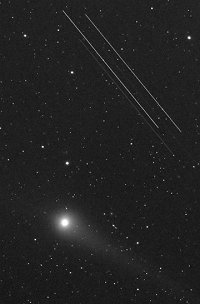
|
John
E Cordiale,
Queensbury, NY USA
Feb. 18, 2009 |
#1,
#2 |
On Feb. 17th and 18th, many
observers of Comet Lulin saw something unexpected. In addition
to the comet, "I kept getting satellite trails in my
images," reports John Cordiale of Queensbury, New York.
"It was like Grand Central Station. Multiple groupings
of satellites traveled through my images for hours. It made
me wonder if I was seeing debris from the recent double
satellite collision."
It certainly looked like flying debris.
But no, what Cordiale and others saw was actually a band
of intact geostationary satellites. Geostationary satellites
orbit Earth twenty-two thousand miles above the equator,
always keeping station above a single point on the ground.
While geosats are stationary with respect to Earth's surface,
they move with respect to the stars. Viewed through the
eyepiece of a star-tracking telescope, the stars are motionless
while the "stationary" satellites streak through
the field of view like so much debris. Strange but true.
From mid-Northern latitudes, geostationary
satellites occupy a band of declinations between approximately
-5 and -7 degrees. By happenstance, Comet Lulin passed through
that band on Feb. 17th and 18th, setting the stage for an
unexpected show. "I had never seen anything like it!"
says Cordiale.
Photo
details: Takahashi FC65 refractor, QSI540 -4022CCD
Camera - single 180 second exposures. |
|
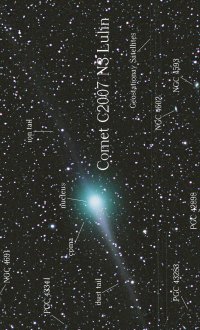
|
James
Champagne,
Ramah, Louisiana, USA
Feb. 19, 2009 |
#1,
#2, more |
Comet
Lulin, stationary satellites and some faint fuzzies....
|
|
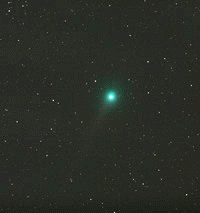
|
Jesus
Pelaez,
Padilla de Arriba, Burgos, Spain
Feb. 17, 2009 |
#1,
#2, more |
Beautiful
comet Lulin and a lot of geostationary satellites.
Photo
details: Long Perng ED 90 telescope at f4,4 Canon 350D astrocooled
4 minute exposure, 800ASA. |
|
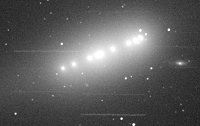
|
W.
Borghini, M.Rivera, G. Cornara, L. Torlai,
B66 Casasco Observatory Italy
Feb. 17, 2009 |
#1,
#2,
more |
Comet
Lulin moving through what appears to be a large quantity
of space debris. Taking multiple exposures of comet Lulin
obtained with a 102 mm refractor telescope equipped with
SXV-H9 CCD. We saw a numbers of objects apparently moving
in the backgound. From 22.42 U.T. to 23.45 of Feb.17th.
In reality, the angular velocity of the objects was about
15°/hour so they are surely geostationary satellites. |
|
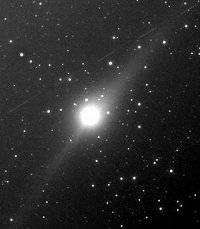
|
Jyrki Keski-Jylhä,
Asikkala, Finland
Feb. 16, 2009 |
#1,
more |
Comet Lulin is so dim when i photographed it. I don't see it visually, but i see comet in pictures. My equipment is William Optick Megrez 90mm FD apo and SBIG STL-6303E camera. Mount is excellent Paramount ME. Clear skies!!
|
more
images:
from
James W. Young of JPL's Table Mountain Observatory, near Wrightwood,
CA; from
Amir H. Abolfath of Maranjab, central desert of Iran; from
E. Guido, G. Sostero and P. Camilleri using a remotely-controlled
telescope in New Mexico; from
Paulo Lobão of Matosinhos, Portugal; from
E. Colzani and G. Ventre of Sormano Astronomical Obervatory
(Co) Italy; from
Arnold Hanslmeier of Bairisch Koelldorf, Austria; |
|





